APV Dryer Handbook - Umbc
APV Dryer Handbook - Umbc
APV Dryer Handbook - Umbc
You also want an ePaper? Increase the reach of your titles
YUMPU automatically turns print PDFs into web optimized ePapers that Google loves.
The Spray Bed dryer is a highly specialized unit that can only produce<br />
agglomerated powder, although the degree of agglomeration can be controlled.<br />
Agglomerates from the Spray Bed dryer exhibit excellent characteristics. They are<br />
very compact and show high agglomerate strength and good flowability.<br />
CONSIDERATIONS AND CONCLUSIONS<br />
While the agglomeration process improves the redispersion, flowability and<br />
non-dustiness of most fine powders, it invariably decreases the bulk density.<br />
The comparisons in Table 5 clearly show that agglomeration improves the powder<br />
wettability and dispersibility. Individual powder particles with a mean diameter<br />
of less than 100 micron are converted into agglomerates ranging in size from<br />
250 to 400 micron with the re-wet method being able to produce the coarser<br />
agglomerate. The powder bulk density will decrease from about 43 lb/ft3 (670 Kg/m3 ) to approximately 28 lbs/ft3 (450 Kg/m3 ). Use of the re-wet method<br />
will expose the product to one additional processing step which can somewhat<br />
affect the proteins, occasionally resulting in a slightly poorer solubility.<br />
Since fluid bed agglomeration can be operated as an independent process, it can<br />
be used in conjunction with existing powder producing equipment. It offers great<br />
flexibility and ease of operation – and provides a convenient way to add<br />
functionality, non-dustiness and value to a number of products.<br />
47











